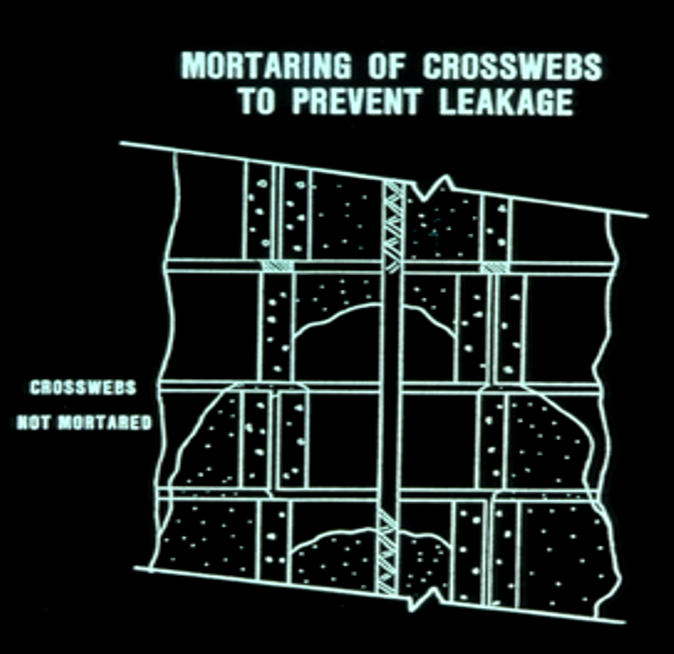|
Are there documents or articles related to the use of rodding grout cells vs vibrating them? There is currently no research or comparative discussions regarding rodding grout. The probable reason is that mechanical vibration has been required for many years by the Building Code Requirements and Specification for Masonry Structures or TMS 402/602. Puddling/ rodding is allowed in pours of 12" or less. Please review paragraph 3.5 E in TMS 602. I know of 1 or 2 jurisdictions that have waived that requirement. You can check your local building department. Another option could be to use TMS 602 paragraph 3.5 G regarding Alternate grout placement. Additional documentation:
TMS 402/602 Building Code Requirements & Specification for Masonry Structures
0 Comments
How big can a but joint be in face brick on wood studs? How much of a variance can there be in but joint sizes with tumbled brick? I believe I am seeing two completely different questions. one is in regard to the material that will used as the substrate in your wall assembly. You will need to contact your local building department to solve the issue of fire-treated vs non combustible plywood. As far as staples in gypsum board, that method should not be used. Adhered veneer is supported by the substrate it is applied to thru the lath and the anchors used to attach the lath. I am attaching a couple of items that will give you direction on the assembly. One item to read is ASTM C1780 Standard Practice for Installation for Adhered Manufactured Stone Masonry Veneer. Even though this Practice does not include thin brick, the substrate preparation is relatively the same. Another document is BIA Tech Note 28c for Thin Brick Veneers. It is an excellent reference document. If you know the brick and its manufacturer additional information technical information is generally available on their website. I hope this is helpful in designing and constructing a beautiful and functional thin brick. Jerry Painter, FASTM Links to additional information:
BIA TECHNICAL NOTES on Brick Construction - Thin Brick Veneer 28C See also: ASTM C1780 - Standard Practice for Installation Methods for Adhered Manufactured Stone Masonry Veneer Why do we mortar the cross webs on either side of a poured cell? If the cross webs aren't mortared what can be done after the fact, that is, after the wall is laid up but prior to it being grouted? The short answer is the obvious answer - the cross webs are mortared to keep the grout from leaking out of the cell being filled. We don't want the grout leaking out for a number of reasons. The important structural reason is that the fluid paste surrounding the pea rock would leak out during the filling and vibrating of the cells leaving the pea rock behind with empty void spaces around the rock at each joint. These void spaces, where the paste is gone and only the rock is left, are commonly know as "honeycombs" in construction. Honeycomb severely weakens hardened grout or concrete where it occurs. This would only apply to course aggregate grout mixes that contain pea rock. High slump fine aggregate grout mix, that contains only sand and aggregate, is going to simply flow through the joints with little or no segregation between the cement and the sand. This uncontrolled leaking of fine aggregate grout does not present a structural problem as much as a construction problem. The fine aggregate grout will actually fill the adjacent cells, costing the contractor more money for grout. The contractor will surely be more reluctant to vibrate the grout after initial water loss as the level of fine aggregate grout would continue to drop as the grout leaks out. Unfortunately, this code required final vibration is essential to make sure that grout bridging in the cell has not formed a hollow areas under the bridged area (see below). Also, the extra grout will increase the weight of the wall. Extra weight, other then in tall multi story buildings, is usually not a problem but should be verified with the designer. So, to answer the second part of the question directly, if the cross webs are not mortared the wall should be grouted with a fine aggregate grout with the proper slump (8" to 11"). It is essential that this fine aggregate grout be re-consolidated after the initial water loss to collapse any void areas. This will require additional topping off of the wall. Section 3.3 B. 4.b.2 of the TMS 602-16 code clearly calls out for the cross webs to be mortared. Fine aggregate grout should not and cannot become a substitute for proper construction. Links to additional documentation:
Grouting Concrete Masonry Walls http://ncma-br.org/pdfs/130/TEK%2003-02A.pdf I have a customer who wants to know what is the maximum height of wall he can pour at one time? Stated another way - what is the maximum drop for grout going down a wall? The grouting height table occurs in two location in the TMS code. In the TMS 402-16 code it appears as Table 3.2.1 and in the TMS 602-16 specifications it appears as Table 6 (same table in both locations).
The table gives the allowable height than you can drop the grout down the wall based on whether the grout is a fine grout (sand only) or a course grout (contain pea rock) along with the clear dimensions of the net opening down through the wall that will be receiving grout. The tables allow for grout to be dropped a maximum of 24' for both fine and course grout. Realistically, it is rare that walls are grouted at heights above 12' - 8" because of the need of substantial bracing for an un-grouted wall 24' in height. Also, typically there is a bond beam around the 12' level which makes it a natural location to grout the wall. The 6th Ed FBC, Building HVHZ Section 2122 simply references the TMS 402/602-16 code for grouting requirements and has no other specific requirements other than a maximum age of 1 1/2 hours after the addition of mix water. I have included with this post a portion of the Masonry Association's Masonry Certification Workshop slides pertaining to Grouting. |
Authors:

Categories
All
Archives
May 2024
|
Masonry Resources |
MAF Websites |
Masonry Association of Florida, Inc. |PO Box 24474 , Fort Lauderdale, FL 33307
Copyright © 2017. All Rights Reserved.
Sitemap
Sitemap


 RSS Feed
RSS Feed
